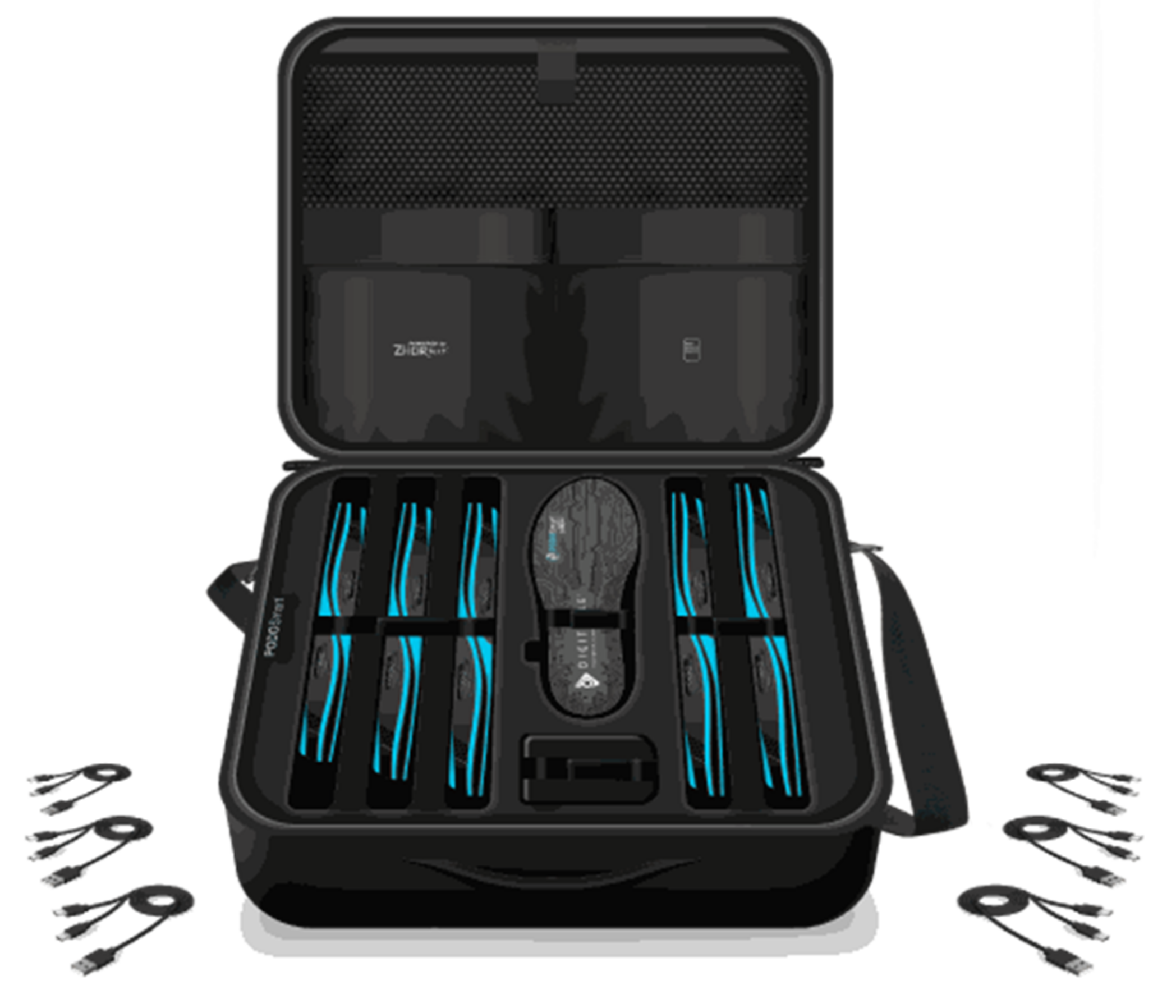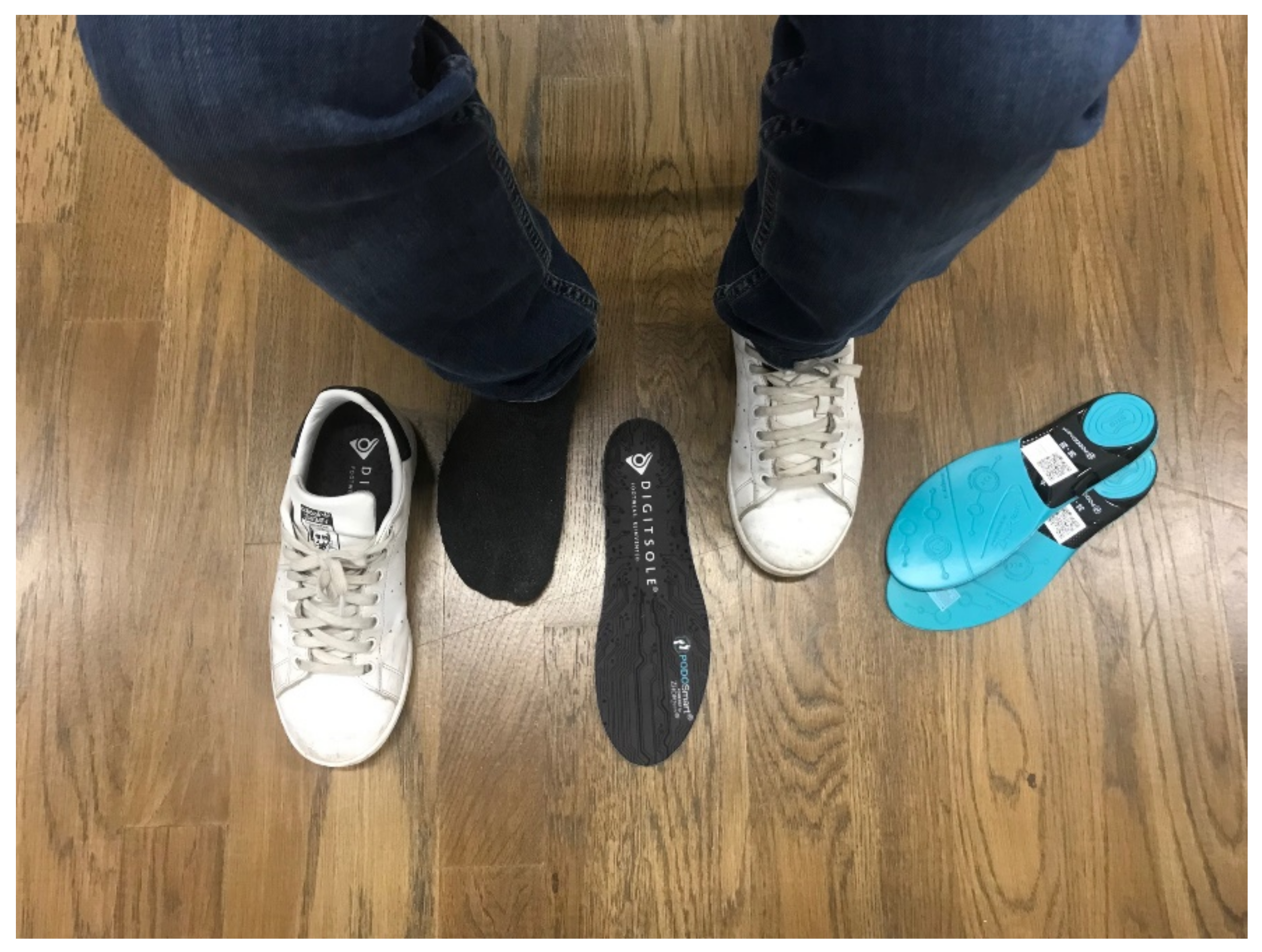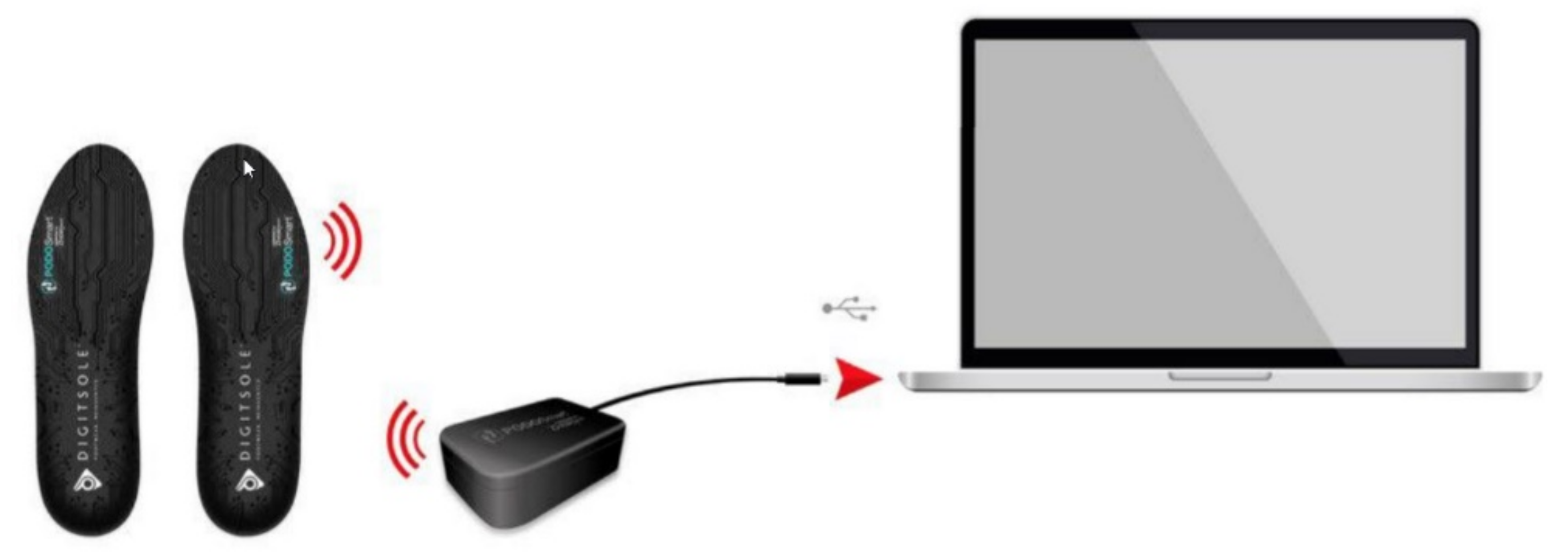Test-Retest Reliability of PODOSmart® Gait Analysis Insoles
Abstract
1. Introduction
2. Materials and Methods
2.1. Samples
2.2. Ethical Considerations
2.3. Experimental Protocol
2.4. Instruments
PODOSmart® Movement Analysis
2.5. Data Analysis
3. Results
4. Discussion
5. Conclusions
Author Contributions
Funding
Institutional Review Board Statement
Informed Consent Statement
Data Availability Statement
Conflicts of Interest
References
- Salarian, A.; Russmann, H.; Vingerhoets, F.J.; Dehollain, C.; Blanc, Y.; Burkhard, P.R.; Aminian, K. Gait assessment in Parkinson’s disease: Toward an ambulatory system for long-term monitoring. IEEE Trans. Biomed. Eng. 2004, 51, 1434–1443. [Google Scholar] [CrossRef] [PubMed]
- DeBerardinis, J.; Dufek, J.S.; Trabia, M.B.; Lidstone, D.E. Assessing the validity of pressure-measuring insoles in quantifying gait variables. J. Rehabil. Assist. Technol. Eng. 2018, 5. [Google Scholar] [CrossRef] [PubMed]
- Ziagkas, E.; Loukovitis, A.; Zekakos, D.X.; Chau, T.D.-P.; Petrelis, A.; Grouios, G. A Novel Tool for Gait Analysis: Validation Study of the Smart Insole PODOSmart®. Sensors 2021, 21, 5972. [Google Scholar] [CrossRef]
- Joint Committee for Guides in Metrology. Evaluation of measurement data- guide to the expression of uncertainty in measurement. JCGM 2008, 100, 1–116. [Google Scholar]
- Buelow, M. Risky Decision Making in Psychological Disorders; Academic Press: Cambridge, MA, USA, 2020. [Google Scholar]
- Serge, M.; Patrick, T.; Duquenoy, F.; Dinh, P.N. Motion systems: An overview of linear, air bearing, and piezo stages. In Micro and Nano Technologies, Three-Dimensional Microfabrication Using Two-Photon Polymerization, 2nd ed.; Baldacchini, T., Ed.; William Andrew Publishing: Norwich, NY, USA, 2020; pp. 303–325. [Google Scholar]
- Hopkins, W.G. Measures of reliability in sports medicine and science. Sports Med. 2000, 30, 1–15. [Google Scholar] [CrossRef]
- Hurkmans, H.L.P.; Bussmann, J.B.J.; Selles, R.W.; Horemans, H.L.D.; Benda, E.; Stam, H.J.; Verhaar, J.A.N. Validity of the Pedar Mobile system for vertical force measurement during a seven-hour period. J. Biomech. 2006, 39, 110–118. [Google Scholar] [CrossRef] [PubMed]
- Putti, A.B.; Arnold, G.P.; Cochrane, L.; Abboud, R.J. The Pedar® in-shoe system: Repeatability and normal pressure values. Gait Posture 2007, 25, 401–405. [Google Scholar] [CrossRef] [PubMed]
- Braun, B.J.; Veith, N.T.; Hell, R.; Döbele, S.; Roland, M.; Rollmann, M.; Holstein, J.; Pohlemann, T. Validation and reliability testing of a new, fully integrated gait analysis insole. J. Foot Ankle Res. 2015, 11, 54. [Google Scholar] [CrossRef] [PubMed]
- Stöggl, T.; Martiner, A. Validation of Moticon’s OpenGo sensor insoles during gait, jumps, balance and cross-country skiing specific imitation movements. J. Sports Sci. 2017, 35, 196–206. [Google Scholar] [CrossRef] [PubMed]
- Oerbekke, M.S.; Stukstette, M.J.; Schütte, K.; de Bie, R.A.; Pisters, M.F.; Vanwanseele, B. Concurrent validity and reliability of wireless instrumented insoles measuring postural balance and temporal gait parameters. Gait Posture 2017, 51, 116–124. [Google Scholar] [CrossRef]
- Peebles, A.; Maguire, L.; Renner, K.; Queen, R. Validity and Repeatability of Single-Sensor Loadsol Insoles during Landing. Sensors 2018, 18, 4082. [Google Scholar] [CrossRef]
- Price, C.; Parker, D.; Nester, C. Validity and repeatability of three in-shoe pressure measurement systems. Gait Posture 2016, 46, 69–74. [Google Scholar] [CrossRef]
- Martínez-Nova, A.; Cuevas-García, J.C.; Pascual-Huerta, J.; Sánchez-Rodríguez, R. BioFoot® in-shoe system: Normal values and assessment of the reliability and repeatability. Foot 2007, 17, 190–196. [Google Scholar] [CrossRef]
- Godi, M.; Turcato, A.M.; Schieppati, M.; Nardone, A. Test-retest reliability of an insole plantar pressure system to assess gait along linear and curved trajectories. J. Neuroeng. Rehabil. 2014, 11, 95. [Google Scholar] [CrossRef] [PubMed]
- Jiang, Y.; Wang, D.; Ying, J.; Chu, P.; Qian, Y.; Chen, W. Design and Preliminary Validation of Individual Customized Insole for Adults with Flexible Flatfeet Based on the Plantar Pressure Redistribution. Sensors 2021, 21, 1780. [Google Scholar] [CrossRef]
- Duong, T.T.H.; Goldman, S.; Zhang, H.; Salazar, R.; Beenders, S.; Cornett, K.M.; Bain, J.M.; Montes, J.; Zanotto, D. Validation of Insole-Based Gait Analysis System in Young Children with a Neurodevelopmental Disorder and Autism Traits. In Proceedings of the 2020 8th IEEE RAS/EMBS International Conference for Biomedical Robotics and Biomechatronics (BioRob), New York, NY, USA, 29 November–1 December 2020; pp. 715–720. [Google Scholar]
- Koo, T.K.; Li, M.Y. A Guideline of Selecting and Reporting Intraclass Correlation Coefficients for Reliability Research. J. Chiropr. Med. 2016, 15, 155–163. [Google Scholar] [CrossRef] [PubMed]
- Hidalgo, B.; Gilliaux, M.; Poncin, W.; Detrembleur, C. Reliability and validity of a kinematic spine model during active trunk movement in healthy subjects and patients with chronic non-specific low back pain. J. Rehabil. Med. 2012, 44, 756–763. [Google Scholar] [CrossRef]
- Nair, P.M.; Hornby, T.G.; Behrman, A.L. Minimal detectable change for spatial and temporal measurements of gait after incomplete spinal cord injury. Top Spinal. Cord. Inj. Rehabil. 2012, 18, 273–281. [Google Scholar] [CrossRef] [PubMed]
- Baker, R. Gait analysis methods in rehabilitation. J. Neuroeng. Rehabil. 2006, 3, 4. [Google Scholar] [CrossRef]
- Macleod, C.A.; Conway, B.A.; Allan, D.B.; Galen, S.S. Development and validation of a low-cost, portable and wireless gait assessment tool. Med. Eng. Phys. 2014, 36, 541–546. [Google Scholar] [CrossRef][Green Version]
- Saggio, G.; Tombolini, F.; Ruggiero, A. Technology-Based Complex Motor Tasks Assessment: A 6-DOF Inertial-Based System versus a Gold-Standard Optoelectronic-Based One. IEEE Sens. J. 2021, 21, 1616–1624. [Google Scholar] [CrossRef]
- Simon, S.R. Quantification of human motion: Gait analysis—Benefits and limitations to its application to clinical problems. J. Biomech. 2004, 37, 1869–1880. [Google Scholar] [CrossRef] [PubMed]
- Alves, R.; Borel, W.P.; Rossi, B.; Palmeira, V.; Eduardo, J.D.C.; Paula, S.C.; Felício, D.C. Test-retest reliability of baropodometry in young asyntomatic individuals during semi static and dynamic analysis. Fisioter. Mov. 2018, 31, e003114. [Google Scholar] [CrossRef]
- Antwi-Afari, M.; Li, H.; Seo, J.; Anwer, S.; Yevu, S.; Wu, Z. Validity and reliability of a wearable insole pressure system for measuring gait parameters to identify safety hazards in construction. Eng. Constr. Archit. Manag. 2021, 28, 1761–1779. [Google Scholar] [CrossRef]
- Healy, A.; Burgess-Walker, P.; Naemi, R.; Chockalingam, N. Repeatability of WalkinSense® in shoe pressure measurement system: A preliminary study. Foot 2012, 22, 35–39. [Google Scholar] [CrossRef] [PubMed]
- De Castro, M.P.; Meucci, M.; Soares, D.P.; Fonseca, P.; Borgonovo-Santos, M.; Sousa, F.; Machado, L.; Vilas-Boas, J.P. Accuracy and repeatability of the gait analysis by the WalkinSense system. BioMed Res. Int. 2014, 2014, 348659. [Google Scholar] [CrossRef] [PubMed]
- Barratt, G.K.; Bellenger, C.; Robertson, E.Y.; Lane, J.; Crowther, R.G. Validation of Plantar Pressure and Reaction Force Measured by Moticon Pressure Sensor Insoles on a Concept2 Rowing Ergometer. Sensors 2021, 21, 2418. [Google Scholar] [CrossRef] [PubMed]
- Farid, L.; Jacobs, D.; Do Santos, J.; Simon, O.; Gracies, J.M.; Hutin, E. FeetMe® Monitor-connected insoles are a valid and reliable alternative for the evaluation of gait speed after stroke. Top. Stroke Rehabil. 2021, 28, 127–134. [Google Scholar] [CrossRef] [PubMed]



| Spatiotemporal Variables | Spatial Variables | Temporal Variables | Angles |
|---|---|---|---|
| Walking speed | Clearance | Contact time | Heel strike |
| Cadence | Stride length | Flying time | Toe strike |
| Taligrade | Heel off | ||
| Plantigrade | Toe off | ||
| Digitigrade | Foot progression angle | ||
| Steppage |
| Gait Variables | 1st Measurement | 2nd Measurement | ||||||||
|---|---|---|---|---|---|---|---|---|---|---|
| M | SD | SEM | MDC95 | MDC% | M | SD | SEM | MDC95 | MDC% | |
| Contact time (Left foot) | 798.8 | 92.22 | 19.66 | 54.49 | 6.82 | 798.0 | 93.94 | 20.03 | 55.52 | 6.96 |
| Contact time (Right foot) | 806.6 | 96.94 | 20.67 | 57.29 | 7.10 | 806.3 | 93.97 | 20.04 | 55.55 | 6.89 |
| Flying time (Left foot) | 506.9 | 40.18 | 8.57 | 23.75 | 4.69 | 512.6 | 44.56 | 9.50 | 26.33 | 5.14 |
| Flying time (Right foot) | 522.5 | 46.96 | 10.01 | 27.75 | 5.31 | 529.7 | 47.45 | 10.12 | 28.05 | 5.30 |
| Taligrade (Left foot) | 162.6 | 81.95 | 17.47 | 48.42 | 29.78 | 158.9 | 83.99 | 17.91 | 49.64 | 31.24 |
| Taligrade (Right foot) | 147.6 | 73.32 | 15.63 | 43.32 | 29.35 | 146.8 | 71.07 | 15.15 | 41.99 | 28.61 |
| Plantigrade (Left foot) | 375.3 | 87.51 | 18.66 | 51.72 | 13.78 | 370.9 | 94.86 | 20.22 | 56.05 | 15.11 |
| Plantigrade (Right foot) | 391.0 | 94.87 | 20.23 | 56.07 | 14.34 | 393.2 | 105.11 | 22.41 | 62.12 | 15.80 |
| Digitigrade (Left foot) | 260.5 | 25.03 | 5.34 | 14.80 | 5.68 | 262.7 | 25.45 | 5.43 | 15.05 | 5.73 |
| Digitigrade (Right foot) | 264.6 | 27.01 | 5.76 | 15.97 | 6.03 | 264.5 | 34.05 | 7.26 | 20.12 | 7.61 |
| Food progression angle (Left foot) | 8.7 | 9.50 | 2.03 | 5.63 | 64.68 | 7.7 | 9.62 | 2.05 | 5.68 | 73.80 |
| Food progression angle (Right foot) | 8.2 | 7.50 | 1.60 | 4.43 | 54.09 | 8.4 | 7.34 | 1.57 | 4.35 | 51.81 |
| Clearance (Left foot) | 1.6 | 0.56 | 0.12 | 0.33 | 20.79 | 1.6 | 0.66 | 0.14 | 0.39 | 24.25 |
| Clearance (Right foot) | 1.7 | 1.09 | 0.23 | 0.64 | 37.50 | 1.8 | 1.15 | 0.25 | 0.69 | 38.50 |
| Steppage (Left foot) | 18.2 | 6.24 | 1.33 | 3.69 | 20.26 | 17.7 | 5.80 | 1.24 | 3.44 | 19.42 |
| Steppage (Right foot) | 15.2 | 5.42 | 1.16 | 3.22 | 21.15 | 16.3 | 5.92 | 1.26 | 3.49 | 21.43 |
| Walking speed | 3.1 | 0.71 | 0.15 | 0.42 | 13.41 | 3.1 | 0.65 | 0.14 | 0.39 | 12.52 |
| Stride length (Left foot) | 112.9 | 11.12 | 2.37 | 6.57 | 5.82 | 112.5 | 10.43 | 2.22 | 6.15 | 5.47 |
| Stride length (Right foot) | 117.5 | 12.80 | 2.73 | 7.57 | 6.44 | 117.5 | 12.55 | 2.68 | 7.43 | 6.32 |
| Cadence | 91.4 | 11.13 | 2.37 | 6.57 | 7.19 | 90.5 | 10.76 | 2.29 | 6.35 | 7.01 |
| Heel strike (Left foot) | −12.8 | 5.05 | 1.08 | 2.99 | 23.39 | −12.7 | 5.10 | 1.09 | 3.02 | 23.79 |
| Heel strike (Right foot) | −15.1 | 5.20 | 1.11 | 3.08 | 20.38 | −15.4 | 5.19 | 1.11 | 3.08 | 19.98 |
| Toe strike (Left foot) | −7.0 | 3.10 | 0.66 | 1.83 | 26.13 | −6.5 | 2.76 | 0.59 | 1.64 | 25.16 |
| Toe strike (Right foot) | −7.4 | 3.60 | 0.77 | 2.13 | 28.84 | −7.9 | 3.82 | 0.82 | 2.27 | 28.77 |
| Heel off (Left foot) | −6.2 | 2.27 | 0.48 | 1.33 | 21.46 | −6.2 | 2.32 | 0.49 | 1.36 | 21.91 |
| Heel off (Right foot) | −6.5 | 3.59 | 0.77 | 2.13 | 32.84 | −6.3 | 3.00 | 0.64 | 1.77 | 28.16 |
| Toe off (Left foot) | −8.1 | 3.85 | 0.82 | 2.27 | 28.06 | −7.9 | 3.61 | 0.77 | 2.13 | 27.02 |
| Toe off (Right foot) | −5.4 | 3.43 | 0.73 | 2.02 | 37.47 | −5.0 | 2.99 | 0.64 | 1.77 | 35.48 |
| Variable | Degree of Reliability | Average Intraclass Correlation | Lower Bound | Upper Bound | Sig. |
|---|---|---|---|---|---|
| Contact time (ms) (L) | Excellent | 0.997 | 0.997 | 0.999 | 0.000 |
| Contact time (ms) (R) | Excellent | 0.989 | 0.974 | 995 | 0.000 |
| Swing time (ms) (L) | Excellent | 0.960 | 0.906 | 0.983 | 0.000 |
| Swing time (ms) (R) | Excellent | 0.906 | 0.787 | 0.960 | 0.000 |
| Taligrade (ms) (L) | Excellent | 0.979 | 0.951 | 0.991 | 0.000 |
| Taligrade (ms)(R) | Excellent | 0.973 | 0.937 | 0.989 | 0.000 |
| Plantigrade (ms) (L) | Excellent | 0.919 | 0.816 | 0.966 | 0.000 |
| Plantigrade (ms) (R) | Good | 0.839 | 0.652 | 0.930 | 0.000 |
| Digitigrade (ms) (L) | Good | 0.842 | 0.658 | 0.931 | 0.000 |
| Digitigrade (ms) (R) | Good | 0.802 | 0.581 | 0.913 | 0.000 |
| Foot progression angle (°) (L) | Excellent | 0.975 | 0.941 | 0.990 | 0.000 |
| Foot progression angle (°) (R) | Excellent | 0.973 | 0.936 | 0.989 | 0.000 |
| Clearance (cm) (L) | Good | 0.816 | 0.607 | 0.919 | 0.000 |
| Clearance (cm) (R) | Good | 0.811 | 0.599 | 0.917 | 0.000 |
| Steppage (°) (L) | Excellent | 0.939 | 0.859 | 0.994 | 0.000 |
| Steppage (°) (R) | Excellent | 0.900 | 0.755 | 0.957 | 0.000 |
| Walking speed (km/h) | Excellent | 0.924 | 0.825 | 0.968 | 0.000 |
| Stride length (cm) (L) | Good | 0.845 | 0.663 | 0.933 | 0.000 |
| Stride length (cm) (R) | Excellent | 0.907 | 0.760 | 0.960 | 0.000 |
| Cadence (steps/min) | Excellent | 0.932 | 0.844 | 0.971 | 0.000 |
| Heel strike (°) (L) | Excellent | 0.952 | 0.889 | 0.980 | 0.000 |
| Heel strike (°) (R) | Excellent | 0.930 | 0.838 | 0.970 | 0.000 |
| Toe strike (°) (L) | Excellent | 0.916 | 0.809 | 0.964 | 0.000 |
| Toe strike (°) (R) | Excellent | 0.917 | 0.811 | 0.965 | 0.000 |
| Heel off (°) (L) | Excellent | 0.914 | 0.804 | 0.963 | 0.000 |
| Heel off (°) (R) | Good | 0.897 | 0.769 | 0.956 | 0.000 |
| Toe off (°) (L) | Good | 0.848 | 0.668 | 0.934 | 0.000 |
| Toe off (°) (R) | Good | 0.845 | 0.663 | 0.933 | 0.000 |
Publisher’s Note: MDPI stays neutral with regard to jurisdictional claims in published maps and institutional affiliations. |
© 2021 by the authors. Licensee MDPI, Basel, Switzerland. This article is an open access article distributed under the terms and conditions of the Creative Commons Attribution (CC BY) license (https://creativecommons.org/licenses/by/4.0/).
Share and Cite
Loukovitis, A.; Ziagkas, E.; Zekakos, D.X.; Petrelis, A.; Grouios, G. Test-Retest Reliability of PODOSmart® Gait Analysis Insoles. Sensors 2021, 21, 7532. https://doi.org/10.3390/s21227532
Loukovitis A, Ziagkas E, Zekakos DX, Petrelis A, Grouios G. Test-Retest Reliability of PODOSmart® Gait Analysis Insoles. Sensors. 2021; 21(22):7532. https://doi.org/10.3390/s21227532
Chicago/Turabian StyleLoukovitis, Andreas, Efthymios Ziagkas, Dimitrios Xypolias Zekakos, Alexandros Petrelis, and George Grouios. 2021. "Test-Retest Reliability of PODOSmart® Gait Analysis Insoles" Sensors 21, no. 22: 7532. https://doi.org/10.3390/s21227532
APA StyleLoukovitis, A., Ziagkas, E., Zekakos, D. X., Petrelis, A., & Grouios, G. (2021). Test-Retest Reliability of PODOSmart® Gait Analysis Insoles. Sensors, 21(22), 7532. https://doi.org/10.3390/s21227532






